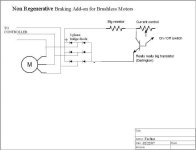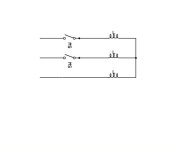I'll have to think about it more.
Instead of the brushed controller/resistor thing, you could just use a very large transistor on a very large heat sink and dissipate the power that way, using the transistor as a variable resistor. Varying the current (braking force) would be fairly simple.
I'm not sure what kind of transistor you'd need to dissipate that kind of power.
I've seen some gigantic IGBT modules on eBay that would probably do it.
I think pumping the power back into the batteries will not shorten their lifespan significantly as long as the charging current is limited to a safe value. Most batteries will have a longer life span if they are not discharged fully.
Instead of the brushed controller/resistor thing, you could just use a very large transistor on a very large heat sink and dissipate the power that way, using the transistor as a variable resistor. Varying the current (braking force) would be fairly simple.
I'm not sure what kind of transistor you'd need to dissipate that kind of power.
I've seen some gigantic IGBT modules on eBay that would probably do it.
I think pumping the power back into the batteries will not shorten their lifespan significantly as long as the charging current is limited to a safe value. Most batteries will have a longer life span if they are not discharged fully.








